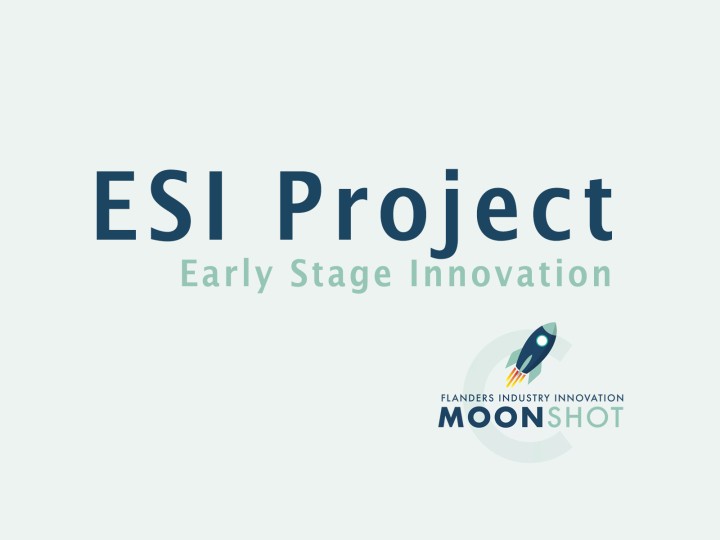ESI Projects

Early Stage Innovation (ESI) projects involve innovative research that is unique with regards to the state-of-the-art, has a clear differentiating factor, and tests disruptive ideas at low TRL levels. In the event of scientific success, the research offers a prospect for future economic applications.
The intended knowledge acquisition of an ESI project technically and substantively deepens the Moonshot roadmap. Additionally, an ESI project is never a stand-alone project, but is sharply defined to fit within a specific Moonshot Research Trajectory (MOT) and to contribute to the KPIs of one or multiple MOTs. Thus, the accumulated knowledge from ESI projects contributes to a more elaborated research trajectory and the realisation of the overall Moonshot goals. A clear (quantitative) contribution to CO2 emission abatement and carbon-circularity is mandatory.
Each ESI project proposal is submitted by a consortium of at least three research groups from at least two Flemish research organisations. A well-performing consortium is slim, balanced, complementary and with good understanding and cooperation. Complementarity or cooperation with a non-Flanders research group should not be avoided if appropriate for competence building and success.
ESI projects have a max. duration of 48 months with a max. budget of 3 million euro at a subsidy percentage of 100%.
Evaluation of ESI Projects
The evaluation of ESI project proposals includes four phases.
First phase
Project consortia can register their project idea for Moonshot by submitting a “Motivated Application Form” (MAF). In a next step, all MAFs are discussed and a consolidated advice is drawn up for each of the MAFs by the WAR. The final decision regarding the selection of project ideas based on the MAFs lies with the governing bodies of the respective spearhead clusters which take into account the consolidated WAR advice.
For MOTs 1-2-3, the decision is taken by the Moonshot industrial expert committees of MOTs 1-2-3 (composed of the companies of the Catalisti innovation committee with additional companies of the steel and petrochemical sector).
For MOT4, the decision is taken by the Flux50 Board of Directors after review by the Moonshot industrial expert committee of MOT4 (composed of the companies of the Catalisti innovation committee with additional companies of the energy sector).
After this first phase, the respective decisions are communicated to the applicants, including the underlying reasoning and, if positive, an overview of the next steps.
Second phase
In the second phase, each ESI project proposal is evaluated, in line with the VLAIO evaluation procedure, by three independent academic experts. VLAIO and the Moonshot operational team select these experts based on their project-specific and subject-related expertise. Naturally, all experts must meet certain objectivity criteria so that no conflicts of interest exist in their relationship with the submitting parties.
Each expert individually prepares a written evaluation of the project proposal that takes into account ESI-specific evaluation criteria, with specific focus on two parts of the project application: the scientific project description and the intended valorisation. Any questions the experts might have are submitted to and answered by the consortium in writing.
Third phase
In the third phase, the project proposal, together with the three evaluation reports and the rebuttal written by the project consortium, is provided to the industrial WAR members, collectively known as the ProjectWAR. The ProjectWAR assesses the project proposal against ESI-specific criteria and the overall Moonshot targets, taking its contribution to the Moonshot roadmap into account. On the basis of the project proposal, the three evaluation reports and the rebuttal, each industrial WAR member formulates an individual advice.
Then, all advices are discussed by the ProjectWAR in group until a consensus is reached. The ProjectWAR then ranks all submitted project proposals. In agreement with the ProjectWAR, a consolidated advice is formulated by the Catalisti and VLAIO representatives, which is presented to the Moonshot Governance Board (MGB).
Fourth phase
The MGB then makes a selection of promising project proposals. On the basis of the ProjectWAR ranking, the MGB can also implement a prioritization if required. Finally, the MGB presents its selection of project proposals to the Beslissingscomité bij het Fonds voor Innoveren en Ondernemen (HBC). Here, a final funding decision is made. If approved by the HBC, the ESI project proposal officially becomes a Moonshot project.
ESI Projects in a nutshell
ESI projects have a max. duration of 48 months with a max. budget of 3 million euro at a a subsidy percentage of 100%.
These projects are formed from a top-down approach. In 2020, industrial input was collected during a broad brainstorm with industrial partners from the chemical, petrochemical, steel and energy sectors. This resulted in a mapping of the specific challenges these sectors face within each Moonshot Research Trajectory (MOT). Based on this input and in consultation with the Scientific Advisory Board (WAR), the Moonshot Governance Board (MGB) has imposed a guiding framework/specific priority themes for each MOT. All full cSBO project proposals are required to adhere to these themes.
MOT1: Biobased Chemistry
Producing biobased precursors from biomass waste for chemicals/materials manufacturing using advanced separation and catalytic processes.
MOT2: Circularity of Carbon in Materials
Focus on chemical recycling of mixed plastics waste as input stream including the valorisation of residual fractions, and/or emphasizing innovative approaches for smart tracking and efficient separation technologies of different plastics/materials to obtain clean recyclable streams.
MOT3: Electrification & Radical Process Transformation
- Innovative CO2 capture from point sources (5-25 wt.% CO2) and conversion to products with strong focus on economics (CAPEX and OPEX reduction) of the processes. Capture and conversion might be combined, but this is not a pre-requisite.
- Power-to-chemicals: modular/decentralized processes (shift from CAPEX to OPEX) with minimal separation cost. (with power being green electricity)
- New/innovative separation technologies as a cheaper and CO2-efficient alternative to distillation.
MOT4: Energy Innovation
- Renewable hydrogen production, storage and transport with focus on economics.
- Valorisation of (residual) heat in industrial processes.
Across all MOTs, these priority themes are imposed in light of the following conditions: “with significant CO2 emission reduction potential” and “with an improved process/product life cycle”.